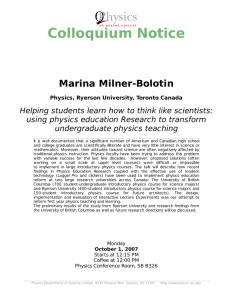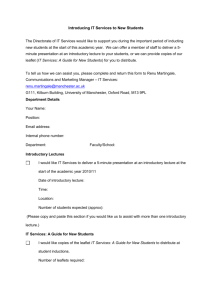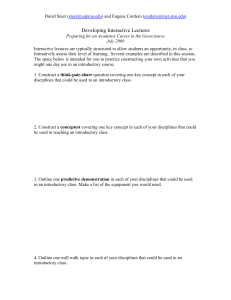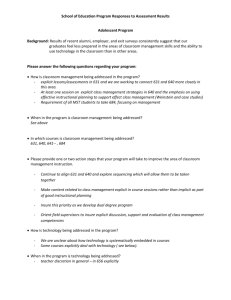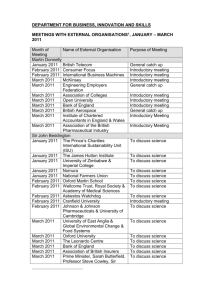Teaching the Process of Science
advertisement
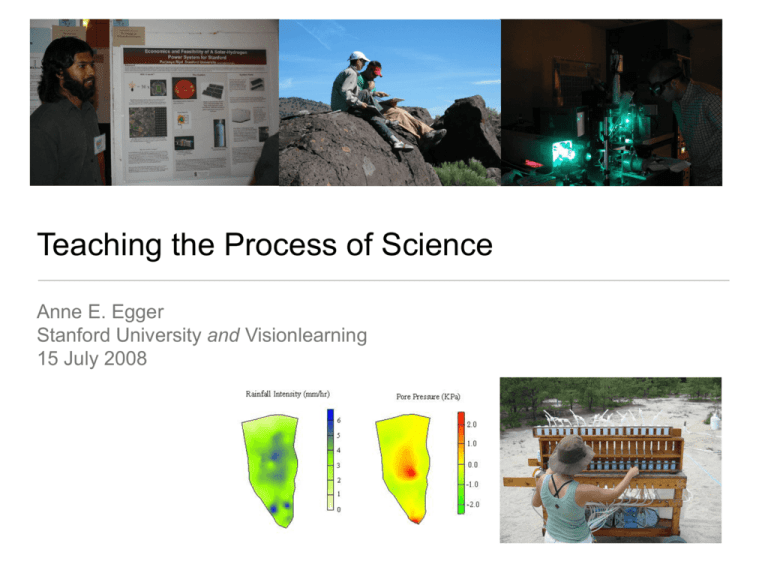
Teaching the Process of Science Anne E. Egger Stanford University and Visionlearning 15 July 2008 A little bit of background: Science in college • Virtually all colleges and universities require students to take at least one science course ~16 million students are enrolled in college in the United States ~41% are enrolled in two-year colleges ~12% go on to major in the natural sciences ~50% of intended science majors switch out in the first two years Data from the NSB 2006 Science and Engineering Indicators A little bit of background: Geoscience in college • Every year, 340,000 undergraduate students take college-level introductory geoscience courses in the United States • 6000 students declare a major in the geosciences < 2% of students from introductory courses • 2700 students graduate with a BS in the geosciences < 50% of declared cohort Two audiences Data from the American Geological Institute A little bit of background: Introductory courses • Our introductory courses are critical for recruiting majors into science disciplines • These same courses may be the only science course that some students take • Often have high enrollment • Often considered the least desirable teaching assignment • Traditionally overstuffed with content delivered in a lecture format The role of introductory courses • ...the primary aim of any undergraduate introductory science course—whether in biology, chemistry, physics, or earth sciences—should be to enable students to appreciate and participate in science as a special way of knowing about the world Alberts, 2005 Science literacy What is science literacy? • An understanding of science content - the theories, observations, ideas, and concepts that form a body of knowledge about the natural world • An understanding of the process of science - the means through which our conceptual and content knowledge was developed and continues to grow and change, and what makes it different from other ways of knowing • An understanding of how science is used - how individuals and societies benefit from and utilize the results of scientific investigation What does geoscience add? • Geologic time/deep time • Spatial thinking, spatial analysis • Complexity of the earth system • Connection to landscape Are we creating geoscientifically literate students? Well.... How do we measure up? • Results of a three-question NSF survey in 2001 and 2004: • In 2001, only 43%of Americans and 37% of Europeans could explain an experiment (46% of Americans in 2004) • 39% of Americans could describe the nature of scientific inquiry • In 2004, only 23% of Americans surveyed could explain what it meant to study something scientifically • As a result, “Americans are as likely to believe in flying saucers as in evolution...” Nicholas Kristoff, NYT Op-ed, Sunday, March 29, 2008 Data from NSB Science and Engineering Indicators 2006 Confidence in science A lethal combination • Don’t understand how science works • High confidence in science and medicine How do we teach to cultivate scientific literacy? ‣ Explicitly teach the process of science Sometimes at the expense of content I know what you’re thinking. Teaching the process: What’s the problem? • Decades of K-12 science teaching reforms have largely been ineffectual (Eisenhart et al., 1996) and most students enter college with little or no understanding of the process of science • Our introductory courses in particular tend to focus heavily on content knowledge rather than process • “One might expect students to be exposed to the real world of science through the laboratory classes that are associated with many science courses. Unfortunately, these laboratory classes generally resemble cookery lessons, and they are remembered even by scientists as unpleasant and dull.” Alberts, 2005 • A true scientific research experience is often limited to seniors who major in science, so non-science majors may never learn the real process of science Teaching the process: Misconceptions • There is one scientific method, and it involves experimentation. most K-12 textbooks and some college ones, too • And you must know the question first. Teaching the process: Misconceptions • There is one scientific method, and it involves experimentation. most K-12 textbooks and some college ones, too • “Everything is science.” Moss et al., 2001 - Interviews of five US high school students in an environmental science class • “Technology is really good... so the computer can generate a good interpretation.” Ryder and Leach, 2000 - Paper survey of 731 science students across Europe + 19 interviews • Conceptual models are not an important part of data interpretation. Ryder and Leach, 2000 • Controversy resolves when experiments prove a theory right. Ryder et al., 1999 Interviews of 11 college students at Leeds involved in final year projects • Scientists may not work alone, but it is unclear how they interact. Ryder et al., 1999 Portrayals in the media • “But while Raymond-Whish’s intimate acquaintance with cancer may harm her credibility as a dispassionate scientist, it may also propel her to help make startling discoveries where no one else has thought to look.” •“On Cancer’s Trail” Florence Williams, High Country News, May 26, 2008 • “... Darwin... was hardly even a scientist in the sense that we understand the term - a highly trained specialist whose professional vocabulary is so arcane that he or she can only talk to other scientists.” •“Who Was More Important, Lincoln or Darwin?” Malcolm Jones, Newsweek, July 14, 2008 Teaching the process: How do we do it? • Emphasize the REAL scientific method(s): “... the positive and negative ideas of science, the fallible and contingent character of science and scientists, and the heterogeneity of science and its products.” (McGinn and Roth, 1999) • Be explicit in teaching the process: “... techniques to improve ... conceptions have met with some success when they have included either historical aspects of scientific knowledge or direct, explicit attention to nature of science.” (Lederman, 2006) • Combine process with content: “... given appropriate teaching contexts, students’ images of science can be significantly broadened and developed.” (Ryder et al., 1999) Teaching the process: How do we do it? • GES 1 Dynamic Earth • Activity-based classes, integrated lecture-lab • No textbook (but NOT no reading) • Shift focus from content to tools and skills • Shift focus from regurgitation to communication ➡ Less breadth, more depth Example activity: Density, Isostasy, and Topography Height ratio Wood block measurements Density ratio Follow-up questions • Using your equation, calculate the thickness of the crust in the Andes, assuming they are made largely of granite and have an average elevation of 5 km above sea level. • Based on what you now know about crustal thickness and isostasy, sketch what you would expect the crust to look like in an east-west cross-section across South America. Include approximate crustal thicknesses. Teaching the process: Exposure to research “I plan to come back next week because I enjoy hearing about concrete examples of what I’m learning in GES 1.” Sasha E., a freshman • Integrated into introductory classes like Dynamic Earth: Required attendance at two research presentations • Additional 1-unit class: GES 3 Current Topics in the Earth and Environmental Sciences Teaching the process: Exposure to research School of Earth Sciences Summer Undergraduate Research Program Teaching the process: People and stories • What do you do every day? (the mundane to the sublime) • Why do you do what you do every day? (what inspired your pursuit of science) • How do you know what we know? (how you collected the data on that graph) Teaching the process: New text resources Visionlearning Teaching the Process of Science Free, online, modular readings that can be integrated with disciplinary content in a science class that include: •Stories about modern research and historical development •Examples from all disciplines Frontispiece from Sprat’s 1667 History of the Royal Society of London •Explicit acknowledgment of misconceptions The Process of Science Visionlearning Teaching the Process of Science • Introduction: What is the Process of Science? • module I. The Process of Science • module II. Teaching the Process of Science (for faculty) • • • • • • • • • • The Process of Science module I. The Nature of Science module II. Scientists and the Scientific Community module III.Scientific Institutions and Societies module IV.Science, Technology, and Engineering module V. Science, Society, and Policy module VI. Scientific Ethics module VII. Ideas in Science: Theories, Hypotheses, and Laws module VIII. Ideas in Science: Scientific Controversy module IX. Ideas in Science: A Short History of Scientific Progress The Process of Science • • • • • • • • • • • • Visionlearning Teaching the Process of Science module X. The Practice of Science module XI. Research Methods: Experimentation module XII. Research Methods: Description module XIII. Research Methods: Modeling module XIV. Research Methods: Comparison module XV. Data: Analysis and Interpretation module XVI. Data: The Role of Statistics module XVII. Data: Visualizing Data module XVIII. Data: Confidence and Uncertainty module XIX. Scientific Writing: Journal Manuscripts module XX. Scientific Writing: Peer Review module XXI. Scientific Writing: Literature • Conclusion: Science and You • module XXII. Science and You Making the change • “As mediators of the cultures of science, science teachers at all levels in the educational system need to make explicit to themselves the images of science communicated through existing ... activities and those additional images they wish to incorporate...” (Ryder et al., 1999) Small changes Big changes Teaching the process of science: Being explicit • Active learning strategies reflect the way that science works BUT those connections need to be made explicit • Engaging students in research early erases the boundary between research and education and makes the process more transparent BUT those connections need to be made explicit • Assigning reading material on the process of science elevates the concepts BUT those connections need to be made explicit Feedback into the scientific enterprise • If faculty at universities “marshal their collective will to reform science education, the impact could be far-reaching. We will send non-science majors into society knowing how to ask and answer scientific questions and be capable of confronting issues that require analytical and scientific thinking. Our introductory courses will encourage more students to become scientists [and to think like scientists] ... Students will see the allure of science and feel the thrill of discovery, and a greater diversity of intellects will be attracted to careers in science. The benefits will be an invigorated research enterprise fueled by a scientifically literate society.” • Handelsman et al., Scientific Teaching, 2001 Goals for this discussion 1. Self-evaluation of how you currently integrate the process of science into your teaching at the course and activity level 2. Sharing ideas with your colleagues for how you already do it and how you could do it better 3. Planning for revisions to your uploaded course and activities Schedule for this discussion • 5-10 min: reflect on integration of the process of science into your course. • What are you doing? Does it meet the “explicit” standard? What kind of feedback do you get from students? What would you like to be doing better? Think about these questions at both the course level and individual activity level. • 20-25 min: discuss the reflections of the people at your table and brainstorm ways that you could highlight the process of science - big and small changes • produce a list of your best ideas for reporting out • upload a word file with this list on the workshop website • make notes about how you might change your materials • 2:50 Report out until we run out of ideas or time • BREAK • Coming back from the break - rearrange yourselves into new table groups for next discussion
